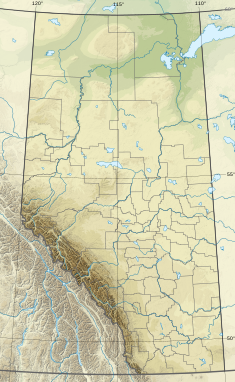| Pembina oil field | |
|---|---|
 | |
| Country | Canada |
| Region | Central Alberta |
| Offshore/onshore | onshore |
| Coordinates | 53°06′N 115°12′W / 53.1°N 115.2°W / 53.1; -115.2 |
| Field history | |
| Discovery | 1953 |
| Start of production | 1953 |
| Production | |
| Producing formations | Cardium Formation, Viking Formation, Rock Creek Member |
The Pembina oil field is one of the largest and most prolific conventional oil fields in the province of Alberta, Canada.
The mature field is centered on Drayton Valley and is named for the Pembina River, which crosses the region from southwest to northeast. It taps reservoirs in the Cretaceous formations of the Western Canada Sedimentary Basin for oil and gas production. The main hydrocarbon-bearing unit is the Cardium Formation. Production also comes from the Viking Formation and sandstone beds of the Fernie Formation such as the Rock Creek Member.
History
The first oil was discovered by Mobil Oil in February 1953, and it started a boom that saw the investment of $900 million in the area.
Gallery
-
Aerial view of oil well locations in Pembina oil field
-
 Pumpjack near Drayton Valley
Pumpjack near Drayton Valley
References
- "Pembina Oil Field". Alberta’s Energy Resources Heritage. Alberta Bulture & Tourism. Retrieved 2021-08-09.
- Justen, John J. (September 1957). "Canada's Pembina Field" (PDF). Journal of Petroleum Technology. 9 (09): 21–26. doi:10.2118/856-G. Paper Number: SPE-856-G.
In mid–1953 the successful completion of the wildcat, Pembina No. 1, recorded the discovery of the Pembina field.
- "History". Town of Drayton Valley. Retrieved 2009-03-04.
| Western Canada Sedimentary Basin | |
|---|---|
| Hydrocarbon history | |
| Depositional regions |
|
| Oil and gas fields | |
This Southern Alberta location article is a stub. You can help Misplaced Pages by expanding it. |
This article about an oil field is a stub. You can help Misplaced Pages by expanding it. |